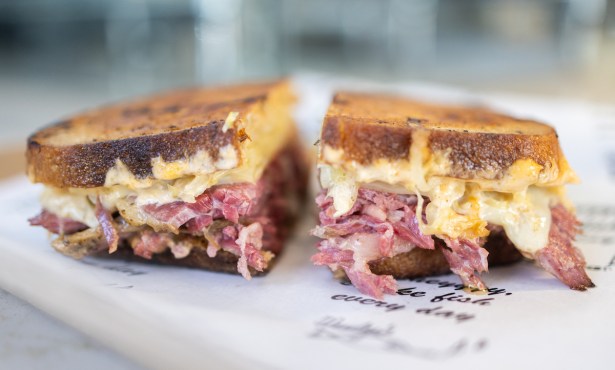Can We Keep Swimming in Sushi?
Casson Trenor's New Book Says Yes and Ty Warner Sea Center Explains How

When that sashimi platter arrives at your table, how easy it is to forget that those creamy slices of flesh came from living animals-and how tempting to ignore that some of those creatures are teetering on the brink of extinction. In his new book, Sustainable Sushi: A Guide to Saving the Oceans One Bite at a Time, environmentalist, seafood lover, and restaurant consultant Casson Trenor tells readers about the grave reality behind most sushi menus while assuring that it’s possible to make sustainable choices when dining out-and it needn’t require ordering seconds of the seaweed salad.
The pocket-sized book runs 40 short chapters, each dedicated to a common sushi menu item, including uni, hamachi, toro, hotate, and suzuki. Trenor translates for readers, providing taxonomic identification of the species from which each item derives. He also describes each animal’s biological history, the common methods used to harvest it, and whether eating the creature is a “sustainable” pleasure.
The greatest taboo of the standard sushi menu is toro, that buttery belly meat of the bluefin tuna. Toro may be the most desired item in the industry, but less savory than each slice of marbled flesh is the bloody story behind it: At the current rate of slaughter, the bluefin tuna will be extinct in a matter of years, warns Trenor. “Bluefin tuna stocks are beyond exploited,” he explained. “The bluefin is in so much trouble all across the planet. If we have any hope of saving this fish, we need to stop eating it.”
In recent history, bluefins commonly grew to more than 1,000 pounds. Today, most are caught before they reach 400, and even 300-pounders have become rare, said Trenor. “This fish is on its way out.”
Bluefin aquaculture is making the matter worse. Bluefin farms technically are not farms but “ranches,” operating by capturing juvenile bluefins and transporting them en masse to pens where they are fattened for slaughter. “We’re stealing the juveniles before they’ve had a chance to breed,” explained Trenor.
Sushi menus worldwide are riddled with other woeful favorites, and Trenor urges diners to follow five rules of thumb when dining out: 1) Never order farmed salmon. 2) Avoid shrimp farmed in tropical countries, especially nations of Southeast Asia. 3) Don’t eat wild fish taken by longlines, and this can include yellowtail, swordfish, mahi-mahi, tuna, shark, and others. 4) Steer clear of hamachi. 5) Say no to unagi.
All of this is old news to the Ty Warner Sea Center’s Sustainable Seafood Program. Launched two years ago and operating in conjunction with the venerable Seafood Watch Program of the Monterey Bay Aquarium, the Sea Center’s program has accelerated during the last six months as more and more restaurants express interest in phasing out unsustainable items and phasing in better options, said Sea Center manager Amanda Hendrickson. Visitors to the Ty Warner Sea Center can pick up pocket-sized Seafood Watch cards to carry as dining-out guides. Seafood Watch also distributes cards specifically geared toward sushi menus.
“We all have the power to turn around the state of the ocean’s fisheries by making informed and knowledgeable seafood choices,” said Hendrickson. “One way to do that is by carrying these cards.” Restaurants that have signed up for consulting advice from the Ty Warner Sea Center include Elements, bouchon, Seagrass, Downey’s, and Wine Cask.
Though more and more seafood items are slipping into the red as fisheries everywhere suffer from overexploitation, numerous sustainable items are available, many of them the products of clean aquaculture. Farmed arctic char, now gaining popularity, is an excellent alternative to salmon. Barramundi, tilapia, catfish, and scallops and other bivalves are also good choices when farmed. Yet consumers must beware of farming operations that produce salmon, hamachi, and unagi, which are ecological disasters. Smart wild options include pot-caught shrimp, pole-caught mahi-mahi (an extremely fast-growing fish), and hand-caught yellowfin tuna. Sustainable Sushi and the Seafood Watch cards reveal many more.
Perhaps the root of most seafood sustainability problems is humans’ tendency to dine off the top of the food chain. We happen to favor large, fast, predatory fish that take many years to grow and require great amounts of smaller fish to sustain themselves. Trenor explained, “We have to stop eating sharks, tuna, and swordfish and instead eat the things that sharks, tuna, and swordfish eat.”
A still wiser choice is to eat species that are themselves herbivorous or omnivorous, like striped bass, tilapia, catfish, and crawfish. Whereas the “fish-in-fish-out” ratio for tuna may be more than 20 pounds of feeder fish for every pound of tuna, plant-eating species can grow at a fish-in-fish-out ratio of fewer than one to one.
In 160 pages, Sustainable Sushi formats an ocean’s worth of information into a manageable handbook, and diners who carry it will hold the power to order wisely, enjoy a guilt-free meal, and help assure that sushi is not just a short-lived pleasure of the present, but a sustainable industry of the future.



